
Israel and its relationship with the West Bank and Gaza has taken a back seat to coverage of the COVID-19 pandemic and the 2020 United States presidential election. Unfortunately, Palestinians continue to suffer under the oppressive hand of Israel, particularly when it comes to their economy. A recent report from the United Nations Conference on Trade and Development (UNCTAD) gives us a sense of just how economically painful Gaza's economic reality is, thanks to Israel and its occupation and military operations.
As background, when Hamas took over control of the 365 square kilometre Gaza Strip in June 2007, Israel mostly closed its five border crossings with Gaza, rendering nearly 2 million people with restricted abilities to move, to leave Gaza for work and curtailed the entry of goods to only basic humanitarian products. At this point in time, only two crossings are open for pedestrian travel in and out of Gaza; Beit Hanoun to Israel and Rafah to Egypt. The Erez crossing is controlled by Israel and passage is limited to humanitarian needs or those with special permits as well as traders and businessmen. It is Gaza's only gateway to the West Bank and East Jerusalem. As well, there were 3 major rounds of hostilities by Israel starting in June 2008 which destroyed much of the Gaza Strip's infrastructure and housing, resulting in the Gaza's Palestinians becoming highly reliant on external aid for their continued existence. These three military operations have claimed the lives of 2,804 Palestinians (and 95 Israelis) as shown on this listing:
1.) During the hostilities that lasted from 27 December 2008 to 18 January 2009, nearly 1,400 Palestinians and 13 Israelis were killed. In addition, 5,380 people were wounded and some 60,000 homes were damaged or destroyed, leaving some 20,000 people homeless.
2.) During the eight-day hostilities in November 2012, 174 Palestinians, including 107 civilians, and 6 Israelis, including 3 civilians, were killed, and some 10,000 homes damaged;
3.) During the hostilities from 8 July to 26 August 2014, 2,251 Palestinians, including at least 146 civilians, and 71 Israelis, of whom 5 were civilians, were killed, and 171,000 homes were damaged, 17,800 of which were rendered completely uninhabitable, thereby displacing their 100,000 inhabitants.
Israel's military operations have resulted in a majority of Gaza's population having no access to clean water, electricity or proper sewage disposal and more than half of Gaza's Palestinians living below the global poverty line.
With that background, let's look at how these actions have impacted Gaza's economy. In the 24 year period from 1994 to 2018, the real GDP of Gaza grew by 48 percent while its population grew by 137 percent, resulting in a 37 percent drop in real GDP per capita. Over that timeframe, unemployment in Gaza jumped by 22 percentage points, hitting 52 percent. Here are two graphs showing real growth in GDP and unemployment over the two and a half decades since 1995:
To put these numbers into perspective, after the Oslo Accords were signed in 1993 and 1995, optimism resulted in the Gaza economy growing by 6.1 percent annually between 1994 and 1999, however, this ended in 2000 following the outbreak of the second intifada when Israel prohibited Palestinian workers from Gaza from working in Israel. As a result, Gaza's economic growth fell to 2 percent annually between 2000 and 2006, falling even further to 0.8 percent annually between 2007 and 2018 for total growth of only 4.8 percent over the entire decade plus. This has meant that Gaza contributes a smaller and smaller share to the entire Palestinian economy (including the West Bank) as shown on this graph:
Here is a table comparing key aspects of the economy of Gaza both prior to the 2007 closure (after Hamas took over control) and 2018:
Note, in particular, the 26.9 percent decrease in real GDP per capita and the 42.1 percent increase in poverty between 2006 and 2018 (with the real poverty line being $255 US per month in 2017).
The sectors most impacted by Israeli-imposed restrictions on the importation of technology and raw materials (i.e. fertilizers, pesticides, construction materials etcetera) include the following:
1.) Agriculture
2.) Fishing
3.) Manufacturing
Now let's look at the estimated impact of the closure, restrictions and recurrent hostilities have had on Gaza's annual real GDP, based on the Gaza's economic growth trend between 1995 and 2006 The first scenario assumes that the Gaza's economy would have continued to grow at 3.7 percent annually from 2007 onwards and the second scenario assumes that, after 2007, Gaza's share of the total Palestinian economy would have remained the same as it was in 2006, growing at 6.6 percent annually, the same rate as the West Bank.
Here is a table showing the results:
Under the first scenario, the cumulative GDP loss for the period from 2007 to 2018 is estimated to be $7.784 billion or 50 percent of the Palestinian GDP in 2018. Under the second scenario, the cumulative GDP loss for the period from 2007 to 2018 is estimated to be $16.69 billion or 107 percent of the Palestinian GDP in 2018.
Here is a graphic which shows the estimates under the two scenarios:
It is quite clear that Israel has been spectacularly successful at handicapping the economy of Palestine as a whole and Gaza in specific. It is only by lifting the closure, reconstructing the Gaza infrastructure and allowing the construction of both airports and seaports that Gaza's economy will grow and, perhaps even thrive. With the change in administrations in Washington, it will be interesting to see how Biden and his new cohort of decision makers deal with the geopolitical nightmare that is Israel's relationship with its Palestinian neighbours.
You can publish this article on your website as long as you provide a link back to this page.

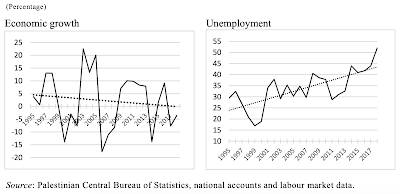
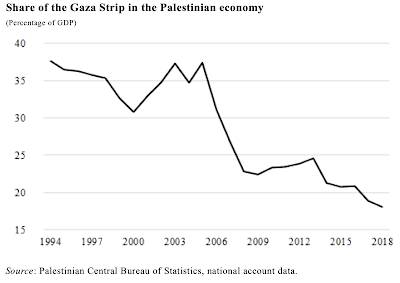
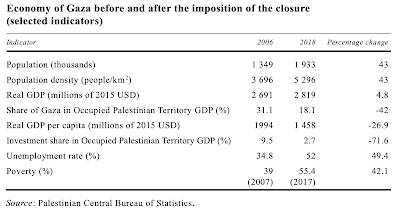
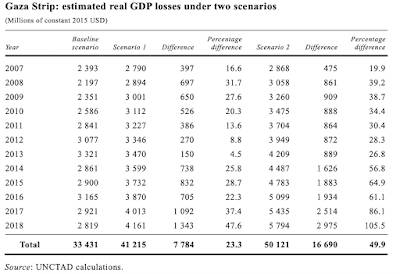
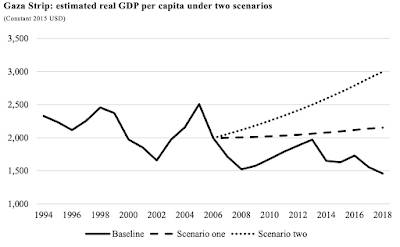
Be the first to comment